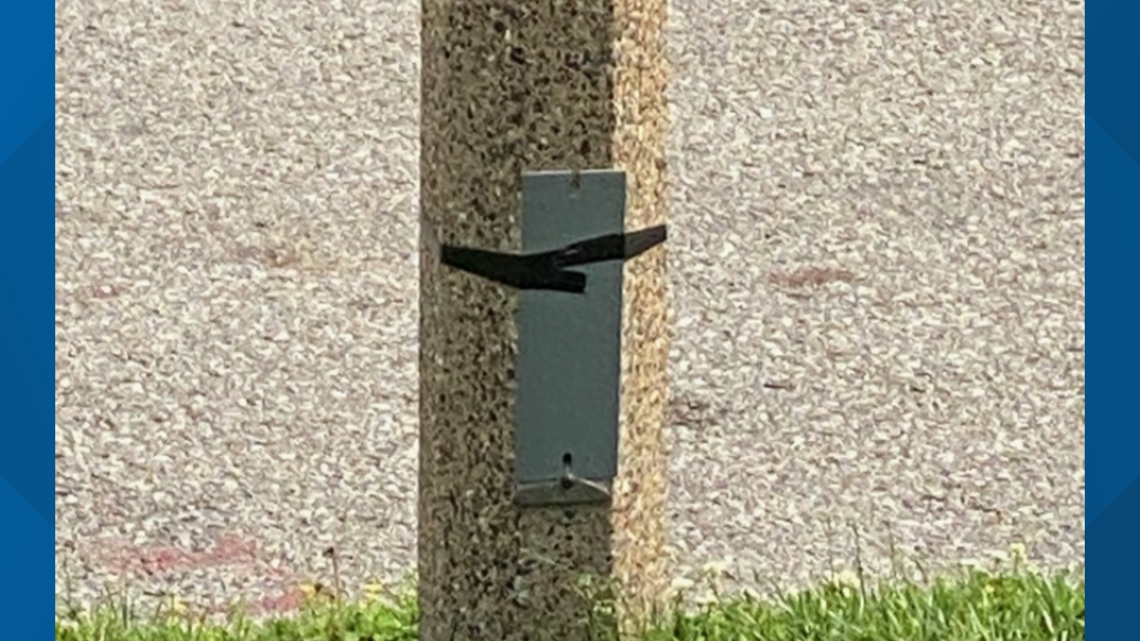ST. LOUIS — Alderpersons and the streets department seem to disagree over fixing dangerous and broken street lights in St. Louis.
In May, the I-Team exposed the dangers hidden at the bases of light poles all over the City of St. Louis. Exposed wires within the reach of children, some of them carrying live current, sat unguarded or unrepaired for months or years.
Michael Santangelo noticed one of those hazards in his neighborhood, The Hill. He reported exposed wires on a light pole to the city, and he wasn’t impressed with the fix.
“It was just a piece of tape,” he said. “It didn't even go all the way around.”


His complaint was one of more than 6,000 that went to the Citizen’s Service Bureau since 2017 about damaged or destroyed street lights. When the I-Team visited some of the lights that went unrepaired the longest, they found exposed wires at bus stops and outside of a home daycare in south St. Louis City.
When licensed electrician Eric Wolff tested one of those lights on a busy street near Forest Park, he confirmed that the wires within reach were carrying live electric current.
We brought these issues to the city’s attention in a one-on-one interview with streets department director Jamie Wilson. After our interview, the streets department put some more permanent fixes in place on all the lights that the I-Team examined, except for a destroyed street light on Clara.
After the I-Team submitted a CSB complaint about the light, the city’s solution was a barrel over wires that the electrician found to be live.
“It'll stop your heart instantly,” Wolff said.
The remnants of the light also included sharp metal.
Who's responsible?
The street light is in Alderman Jeffery Boyd’s jurisdiction, Ward 22.
“We're lucky nobody has been electrocuted,” said Boyd. “It’s irresponsible for the street department to allow that to be in a neighborhood, especially with a lot of kids. I mean, this apartment complex has a lot of children over there.”
The I-Team learned that this broken light was first reported to the streets department more than two years ago. After putting a barrel over it, they closed the complaint, leaving the site with dangerous wires and metal and without a functioning light. Eventually, the barrel was removed.
“When they are knocked down or damaged, we have to contact whoever the funding source was that originally installed that in order to get the replacement equipment,” Wilson said. “Oftentimes it's an alderperson.”
Boyd says he was never contacted about the need to replace the light. He wasn't previously made aware that it fell to him to determine funding.
“If we don't know that they're down because we don't know everything that's going on in our neighborhood, how do we know to replace it?” he said. “How dare the street department say that. That's on the alderman. It is not. It’s on them.”
Limited funds for ward improvement
Boyd is now involved in replacing two lights on the block, and it won’t be cheap. Each decorative light used on the street costs $6,000. Wards have to pay for them from their allocated capital improvement funds.
Wilson says that the city pays to fix or replace 95% of the more standard “cobra head” lights when they break.
“It shouldn't be incumbent upon the alderman to go into the small amount of capital improvement funds we have to replace the decorative lights or any lights in the neighborhood. That should be totally a street department project,” said Boyd.
“The fact that this has set there for a year or two, that's unacceptable. They need to pay more attention.”
Boyd sent documents to show that the process of getting an estimate for street-light replacement from the city has sometimes been a months-long process. Boyd is starting the process for the street lights in question.
An estimate he received for replacing a total of seven light poles added up to $42,434. That money would have to come from the capital improvement funds allocated to each alderperson, roughly $275,000 per year.
He added that replacing the light pole on Clara could take an additional four months.
One street light at a time
For the street light on The Hill that caught Santangelo’s attention, things looked different after the I-Team submitted a CSB complaint.
“I'm sure this fell through the cracks somewhere,” Santangelo said. “Reached out to you, and now it's gotten fixed.”
The day after the I-Team filed the complaint, the city installed a permanent cover secured with screws, not tape.

